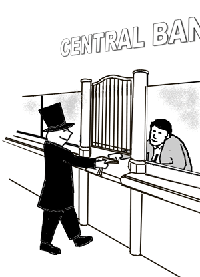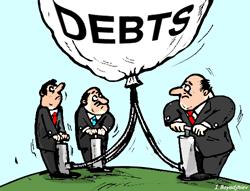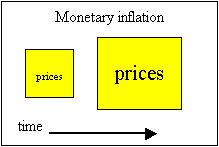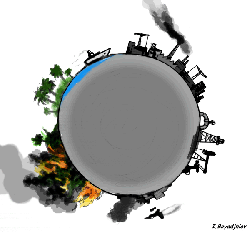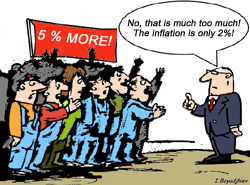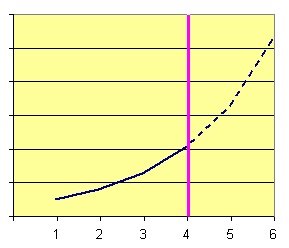The Cancer of Bankers
CAPITALISM, 18 Feb 2019
Rudo de Ruijter | Court Fool – TRANSCEND Media Service
In The magic of bankers [TMS 11 Feb 2019] you have been able to read how bankers create balances for loans with a simple line of bookkeeping. There is no money involved. The money for the balances doesn’t even exist. This extremely lucrative trick incites the bankers to supply as many loans as possible, but there is more. There are specific growth impulses that make it impossible to stop the growth of the outstanding loans. Not even with regulations. This has tremendous consequences for our society.
- The creation of the real money
Banks need only a little bit of money to pay the differences between incoming and outgoing payments among them. [1] They also need some money for customers who ask for bank notes, for instance at ATM’s. Banks obtain this money by selling securities (like state obligations / treasury bills) to the central bank, where each bank has an account.
The latter then adds the value into the account of the bank. This way, the official money comes about as numbers at the central bank. The central bank is the only bank entitled to print banknotes. Also, the banks can withdraw money from their central bank account in the form of bank notes, to keep them ready for customers who ask for them.
- Repro-contract
The sale of securities to the central bank is not an ordinary sale. There is a condition attached to it: The banker must promise to buy back these securities at an agreed date at an agreed higher price. Thus, the banks dispose of the money just temporarily and they have to sell and buy back securities regularly.
The First Growth Impulse
The fact that each time the central bank demands more money back than it has initially created, means that the banks never have enough money to buy back the securities. They have to sell more securities to buy back the preceding ones.
This causes increasing costs to the banks. To compensate these costs they will have to generate more income, thus supply more loans all the time.
Note, when customers keep bank notes at home, the bank which supplied them will bear the cost for them permanently. For the banks this is one of the reasons to reward customers when they deposit their money in a savings account.
- Inflation: increasing prices
When supplying loans, the banks create new balances out of their hat, but they don’t have a magic stick to create more goods to buy. And when consumers have more ‘money’ to spend for the same amount of goods, prices will simply go up. Each unit of money becomes less worth and with that also our bank balances.
- Inflation: increasing working pressure
And if we don’t want to get poorer, we will have to work harder to make up for the loss of value of our money. It is a permanent race against impoverishment.
You can also see it this way: By working harder we try to obtain a part of the newly created bank balances.
- The fairy-tale of economic growth
The tale that an economy should grow to be healthy comes out of the need of the bankers to supply more loans all the time. More loans means more balances in circulation and loss of value of our money. To prevent impoverishment we have to produce more in order to earn more all the time. That is nice for the bankers, but not for us and not for the Earth.
- Inflation and Consumer Price Index
The inflation is often expressed as the annual price increase of a basket of products of an average household, the Consumer Price Index. However, when products in this basket become too expensive, they are replaced by cheaper ones. The reasoning is, that the average household would do so too. Thanks to this trick the real price increase stays hidden. The Consumer Price Index can never exceed the increase in income of the average household. The latter cannot pay higher prices! [2]
- Inflation: Advantage for the borrowers
With inflation the borrowers have the advantage that the worth of the principal they have to pay back decreases over time. When the inflation is 2 percent, it can be compared with 2 percent less interest. At an interest of 6 percent this equals 1/3 of the interest burden. The losers are the successive users of the corresponding bank balances. They lose exactly the same amount by the increase of prices. [3]
The Second Growth Impulse
The risk for the bankers is that borrowers don’t pay back a part or the whole of their loan. In a general way, the number of defaulters increases exponentially with the increase of the interest rate.
When the interest rate is 6 percent and the inflation 2 percent, this equals a net interest of 4 percent. Thanks to this inflation the bankers avoid the defaulters who would come about at an interest rate between 4 and 6 percent, that is to say the majority. (When we estimate, that without inflation, at 6 percent interest there would be ten times as many defaulters as at 1 percent interest, the banks avoid 2/3 of the defaulters thanks to the inflation!)
So banks have an interest in supplying more and more loans to keep the inflation going and avoid the majority of defaulters. (Probably most bank directors aren’t even aware of that. They simply want to present better results each year to keep their well paid job…)
- Inflation: no loss for the banks
The fact that during the loan the inflation decreases the worth of each installment doesn’t hurt the banks. When they have created a balance of 1,000 euros for a loan, then 1,000 euros will have to be booked as paybacks to reduce the created balance to zero again. Nothing more, nothing less.
Inflation does have negative consequences for the interest the banks receive. The worth of the interest decreases during the loan too. And that is the income for the banks. But you may be confident the banks have foreseen this decrease in worth and have demanded a little higher interest in advance. There are also banks which make borrowers pay the interest first and the paybacks only afterwards. This way they collect the interest before its worth decreases by inflation.
- Decreasing inflation: system risk
When inflation decreases, or worse, when there is deflation, it may happen that all banks simultaneously are confronted with an increasing number of default payments. This is because the inflation-advantage for the borrowers disappears and the installments become harder to earn. In theory, when the borrower cannot pay anymore, banks have to book losses. However, banks cannot cope with many losses. By itself the bank’s capital may seem huge, but it only represents about 5 to 8 percent of the outstanding loans. When defaulters become systemic, they go bankrupt. That is why they rather convert bad loans into longer loans, in a way the monthly installments for the borrowers become lower and the latter might be able to pay anyway. This way losses are prevented or postponed.
- Savings
At the supply of loans balances come about. At payment orders balances disappear with the clients and new balances appear with the beneficiaries. [1] For each balance goes, that there is somewhere a borrower, who still has to pay back this amount. As long as these amounts are in use for payments the borrower can try to earn the amount by supplying labor and/or goods to someone else.
Here, savings form a problem. Savings are bank balances which are not in use for payments indefinitely. These amounts are parked in savings accounts.
The borrowers cannot obtain these amounts to pay back their loans. There are less balances in payment accounts than must be paid back over time. For the banks the risk increases, the borrowers cannot pay their debts at the set date.
Less balances in use for payments also means deflation. For a same quantity of goods and services there are less balances to pay for them. The value of each unit of money increases, the agreed amounts for the paybacks become harder to earn.
The Third Growth Impulse
To counter the danger of deflation, the banks compensate the outflow into savings accounts by the supply of extra loans. (For the ignorant economists it now looks as if the savings are lent out. However, the savings are nothing else than a recognition of debt by the banks to their customers and not a piggy bank with money.) The supply of these extra loans prevents the risk that the amount of balances in payment transactions decreases.
It is true there are more borrowers now chasing the same balances to pay back their loans, but because the installments are spread over a longer period, the banks can take measures in time. Each time an amount is paid back, the bank can lend out a same amount. This solves the problem temporarily each time.
Cancer
With all these impulses, the amount of outstanding loans grows like cancer. And it causes tremendous costs: the interest! All these balances start as interest bearing loans. On each and every bit of balances in our bank accounts there is somewhere a borrower paying interest! All this interest to be paid is incorporated directly or indirectly [5] in the prices of products at the successive production stages. Finally all the interest has to be paid by the consumers, who are last in the chain. In 1950 the interest in consumer prices was 7 percent. In 1975 it was 14 percent. In 2000 this was 31 percent. Today it is over 35 percent! [6]
 Summary
Summary
Banks need to obtain all the time more money from their central bank, because the central bank demands more money back than it supplies and also because customers often keep banknotes under their mattress or in their vault. The banks’ cost for the acquisition of money increases and banks supply more loans all the time to cover the expenses. More loans means more balances in use and inflation.
By the inflation the borrowers have the advantage that during the loan the amounts to be paid back become less worth and can be earned more easily. The banks have the advantage they have less default payments. On the contrary, the outflow to savings causes a decrease of balances in payment transactions (deflation) and increases the risk of massive default payments. The banks counter this risk by supplying extra loans.
The permanent growth of bank balances is a cancerous tumor. We get deeper and deeper into debt. Each year the burden of interest grows. In 1950 the part of interest in our consumer expenses was 7 percent. In 1975 it was 14 percent. In 2000 this was 31 percent. Today it is over 35 percent! [6]
NOTES:
[1] For payments among banks only very little money is needed.
See The magic of bankers, scheme Payments between three banks
[2] For more details see: Secrets of money, interest and inflation, item Consumer Price Index and Inflation
[3] For more details see Secrets of money, interest and inflation, item Inflation: make the population pay for the use of money
[4] Image: from Wikimedia
[5] Indirectly for instance via wages. Today employees spend a part of their wages on the interest they pay to their bank. If they wouldn’t have any interest to pay, they would be able to purchase the same things with much lower wages.
[6] Helmut Creutz:
“All costs, that accumulate during production and intermediate price building, end up in the final prices. They have to be paid by the households, which, as last in the chain, cannot roll these costs to others, and they must bear them directly or indirectly in their expenses.
According to the monthly bulletin of the Bundesbank of September 2003 the total expenses of households in 2000 amounted to 1.201 billion euros, the interests on credit (the interests collected by the banks) were 370 billions. From these figures, representing per household 31,600 euros, respectively 9,740 euros, appears a part of interest in the expenses of 31 percent.”
In 1950 this was only 7 percent, in 1975 this was 14 percent, in 2000 it was 31 percent and today over 35 percent.
___________________________________________________
Rudo de Ruijter is an Independent researcher in the Netherlands.
You may freely copy and republish this article in newspapers, magazines, webpages, multimedia etc.
Go to Original – courtfool.info
DISCLAIMER: The statements, views and opinions expressed in pieces republished here are solely those of the authors and do not necessarily represent those of TMS. In accordance with title 17 U.S.C. section 107, this material is distributed without profit to those who have expressed a prior interest in receiving the included information for research and educational purposes. TMS has no affiliation whatsoever with the originator of this article nor is TMS endorsed or sponsored by the originator. “GO TO ORIGINAL” links are provided as a convenience to our readers and allow for verification of authenticity. However, as originating pages are often updated by their originating host sites, the versions posted may not match the versions our readers view when clicking the “GO TO ORIGINAL” links. This site contains copyrighted material the use of which has not always been specifically authorized by the copyright owner. We are making such material available in our efforts to advance understanding of environmental, political, human rights, economic, democracy, scientific, and social justice issues, etc. We believe this constitutes a ‘fair use’ of any such copyrighted material as provided for in section 107 of the US Copyright Law. In accordance with Title 17 U.S.C. Section 107, the material on this site is distributed without profit to those who have expressed a prior interest in receiving the included information for research and educational purposes. For more information go to: http://www.law.cornell.edu/uscode/17/107.shtml. If you wish to use copyrighted material from this site for purposes of your own that go beyond ‘fair use’, you must obtain permission from the copyright owner.
